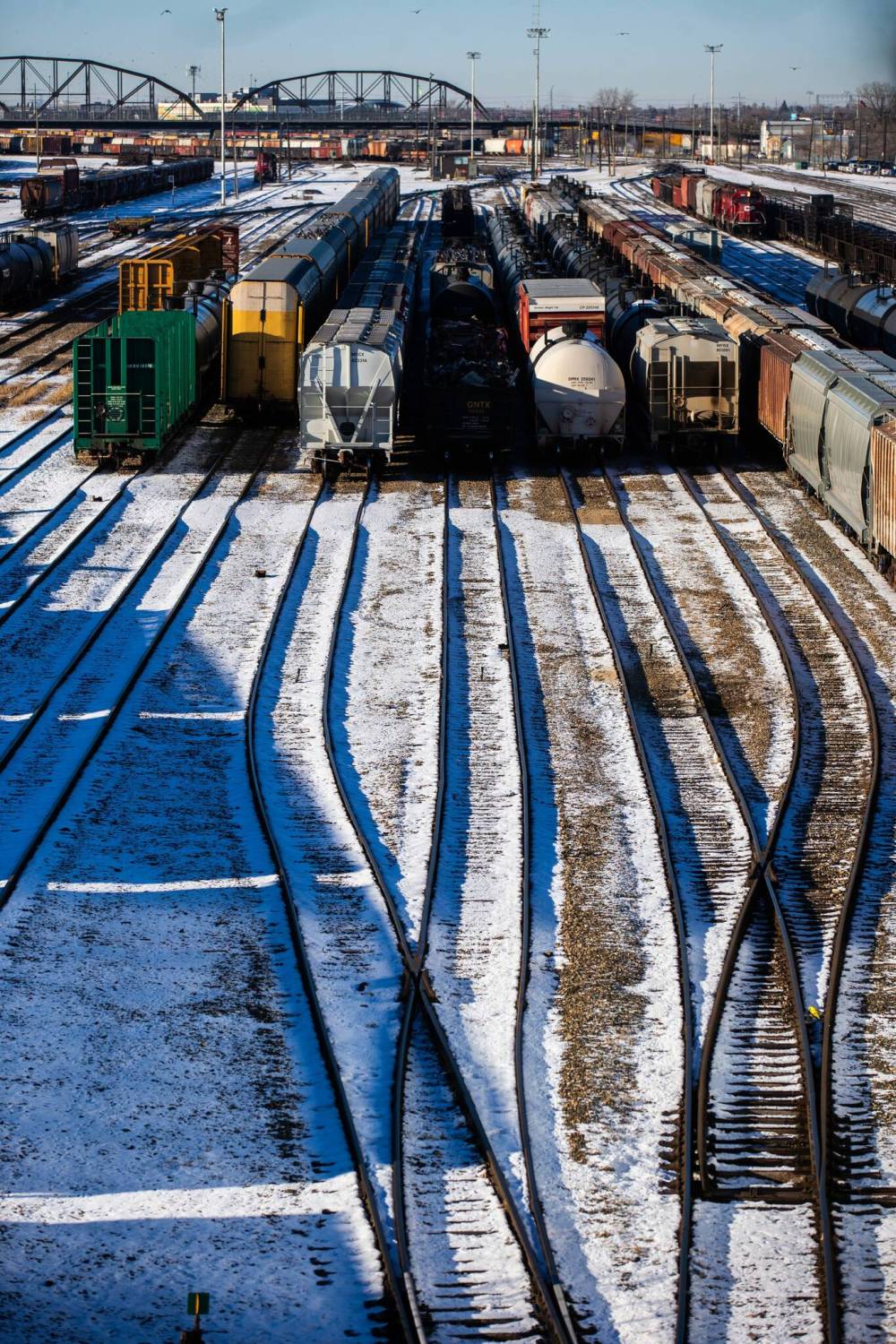Kinew plans to get train-yard relocation study back on the rails; proponents ready to climb aboard
Read this article for free:
or
Already have an account? Log in here »
To continue reading, please subscribe:
Monthly Digital Subscription
$0 for the first 4 weeks*
- Enjoy unlimited reading on winnipegfreepress.com
- Read the E-Edition, our digital replica newspaper
- Access News Break, our award-winning app
- Play interactive puzzles
*No charge for 4 weeks then price increases to the regular rate of $19.00 plus GST every four weeks. Offer available to new and qualified returning subscribers only. Cancel any time.
Monthly Digital Subscription
$4.75/week*
- Enjoy unlimited reading on winnipegfreepress.com
- Read the E-Edition, our digital replica newspaper
- Access News Break, our award-winning app
- Play interactive puzzles
*Billed as $19 plus GST every four weeks. Cancel any time.
To continue reading, please subscribe:
Add Free Press access to your Brandon Sun subscription for only an additional
$1 for the first 4 weeks*
*Your next subscription payment will increase by $1.00 and you will be charged $16.99 plus GST for four weeks. After four weeks, your payment will increase to $23.99 plus GST every four weeks.
Read unlimited articles for free today:
or
Already have an account? Log in here »
Hey there, time traveller!
This article was published 28/12/2023 (689 days ago), so information in it may no longer be current.
Manitoba’s premier wants to study the feasibility and cost of moving rail yards and lines out of Winnipeg — a mammoth undertaking that he believes should be done incrementally.
In a year-end interview, Wab Kinew signalled an intent to explore the idea in 2024.
“This is something that’s a hugely expensive potential proposition,” he said. “But maybe if we look at it in a decades-long timeline… rather than a next-year timeline, then maybe it is realistic.”
MIKAELA MACKENZIE / WINNIPEG FREE PRESS Rail lines divide the city, as seen from the Salter Street bridge. 
Former federal Liberal cabinet minister Lloyd Axworthy and other proponents told the Free Press they are encouraged by Kinew’s willingness to look into the issue.
“There seems to be serious intent,” said Axworthy, who endorsed Kinew in October’s provincial election.
“It’s exciting to hear someone at that level who’s talking about it seriously,” said Point Douglas Residents Committee chair Catherine Flynn.
Kinew has discussed the topic with Mayor Scott Gillingham and Liberal MP Dan Vandal, who is Manitoba’s senior federal cabinet minister.
“Rail relocation would be an extensive process that would require study and support from partners and all levels of government,” Michael Clarke, a spokesman for Vandal (Saint Boniface—Saint Vital), wrote in an email.
“Minister Vandal has every intention to continue working with Premier Kinew and Mayor Gillingham on this file as it moves forward and we are open to having a discussion on rail relocation with partners.”
Kinew said the first step is to determine whether such a project is feasible and if it can be completed it in a fiscally responsible way.
“I think a study and answering some of those questions, particularly within our current capital restraint that we have at the provincial level, would be time well-spent,” the NDP premier said.
The idea of relocation has been around for decades. Talks appeared to accelerate after a train derailment at the McPhillips Street underpass in April and the indefinite closure of the 111-year-old Arlington Street Bridge in November.
The aging bridge crosses the the Canadian Pacific rail yards that divide central and northern neighbourhoods.
Axworthy said a study is needed to provide accurate estimates of time, cost and resources.
It would require an “effective level” of participation of all stakeholders, he said.
Axworthy agreed relocation would have to be done incrementally.
“It’s not going to be waving a magic wand and the railways are sitting in a new location,” he said.
“It’s not going to be waving a magic wand and the railways are sitting in a new location.”–Lloyd Axworthy
In a letter to the Free Press last month, Axworthy said the movement of dangerous chemicals and petroleum products imperils the safety of Winnipeg.
The letter referenced the 2013 rail disaster and explosion that killed nearly 50 people in Lac-Mégantic, Que.
On Thursday, Axworthy said relocation would provide big opportunities for Winnipeg, while reducing the railway footprint.
Proponents say the freed-up land could be used to build new homes, commercial buildings, transportation corridors, walking and cycling paths, and greenspace.
Axworthy said the removal of rail networks within city limits would eliminate a north-south divide in the city and the need for expensive bridges.
Flynn said residents should be consulted during a relocation study.
“We’d like to be involved,” she said of the Point Douglas committee, which has a “remove the rails” subcommittee.
In addition to general safety concerns, residents are worried about air, soil and noise pollution.
“The trains are so long now,” said Flynn. “They rumble past and make your house shake.”
“The trains are so long now… They rumble past and make your house shake.”–Catherine Flynn, Point Douglas Residents Committee chair
The removal of rail yards and lines could help to transform downtown Winnipeg, create more opportunities for tax revenue, and provide environmental and social benefits, she said.
As for the financial cost, the word “billions” is occasionally floated. Businessman and rail enthusiast Art DeFehr wrote a position paper in 2015 in favour of relocation. It said, based on comments by a senior CN Rail executive, it would cost about $1 billion to move the lines and free up about $300 million in land.
DeFehr on Thursday expressed his continued support for a study.
Canadian Pacific Kansas City Ltd. spokesman Terry Cunha referred the Free Press to an earlier statement which said CPKC may participate if a community wants to study moving certain rail lines.
“However, relocation of rail lines and yards is a complex and serious issue which would involve CPKC, local and national customers, regulators, local community organizations and all levels of government,” the statement said. “An extensive review would need to take place to determine the impact to customer service and the full cost to all stakeholders, which will be significant.”
MIKAELA MACKENZIE / WINNIPEG FREE PRESS The idea of relocating the rail yards and lines has been around for decades.
Gillingham’s 2022 mayoral campaign included a pledge to support incremental relocation opportunities. Last month, he suggested first looking at what spur lines or other parts of the rail system could be removed and developed.
A former spur rail line between Gateway Road and Raleigh Street was converted into a 5.5-kilometre paved trail known as the Northeast Pioneers Greenway.
After April’s derailment, then-Progressive Conservative premier Heather Stefanson said she was willing to discuss relocation with other levels of government.
In 2016, her predecessor, Brian Pallister, scrapped a task force that was launched months earlier by the previous NDP government.
Then-premier Greg Selinger committed $400,000 for the task force, which was to be headed by former Quebec premier Jean Charest.
— with files from the Canadian Press
chris.kitching@freepress.mb.ca

Chris Kitching is a general assignment reporter at the Free Press. He began his newspaper career in 2001, with stops in Winnipeg, Toronto and London, England, along the way. After returning to Winnipeg, he joined the Free Press in 2021, and now covers a little bit of everything for the newspaper. Read more about Chris.
Every piece of reporting Chris produces is reviewed by an editing team before it is posted online or published in print — part of the Free Press‘s tradition, since 1872, of producing reliable independent journalism. Read more about Free Press’s history and mandate, and learn how our newsroom operates.
Our newsroom depends on a growing audience of readers to power our journalism. If you are not a paid reader, please consider becoming a subscriber.
Our newsroom depends on its audience of readers to power our journalism. Thank you for your support.









